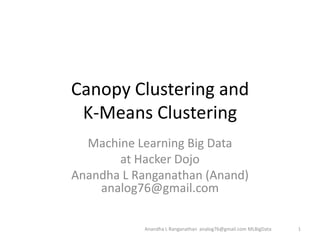
Canopy kmeans
- 1. Canopy Clustering and K-Means Clustering Machine Learning Big Data at Hacker Dojo Anandha L Ranganathan (Anand)analog76@gmail.com Anandha L Ranganathan analog76@gmail.com MLBigData 1
- 2. Movie Dataset Download the movie dataset from http://www.grouplens.org/node/73 The data is in the format UserID::MovieID::Rating::Timestamp 1::1193::5::978300760 2::1194::4::978300762 7::1123::1::978300760 Anandha L Ranganathan analog76@gmail.com MLBigData
- 3. Similarity Measure Jaccard similarity coefficient Cosine similarity Anandha L Ranganathan analog76@gmail.com MLBigData
- 4. JaccardIndex Distance = # of movies watched by by User A and B / Total # of movies watched by either user. In other words A B / A B. For our applicaton I am going to compare the the subset of user z₁ and z₂ where z₁,z₂ ε Z http://en.wikipedia.org/wiki/Jaccard_index Anandha L Ranganathan analog76@gmail.com MLBigData
- 5. Jaccard Similarity Coefficient. similarity(String[] s1, String[] s2){ List<String> lstSx=Arrays.asList(s1); List<String> lstSy=Arrays.asList(s2); Set<String> unionSxSy = new HashSet<String>(lstSx); unionSxSy.addAll(lstSy); Set<String> intersectionSxSy =new HashSet<String>(lstSx); intersectionSxSy.retainAll(lstSy); sim= intersectionSxSy.size() / (double)unionSxSy.size(); } Anandha L Ranganathan analog76@gmail.com MLBigData
- 6. Cosine Similiarty distance = Dot Inner Product (A, B) / sqrt(||A||*||B||) Simple distance calculation will be used for Canopy clustering. Expensive distance calculation will be used for K-means clustering. Anandha L Ranganathan analog76@gmail.com MLBigData
- 7. Canopy Clustering- Mapper Canopy cluster are subset of total popultation. Points in that cluster are movies. If z₁subset of the whole population, rated movie M1 and same subset are rated M2 also then the movie M1and M2 are belong the same canopy cluster. Anandha L Ranganathan analog76@gmail.com MLBigData
- 8. Canopy Cluster – Mapper Anandha L Ranganathan analog76@gmail.com MLBigData First received point/data is center of Canopy . Receive the second point and if it is distance from canopy center is less than T1 then they are point of that canopy. If d(P1,P2) >T1 then that point is new canopy center. If d(P1,P2) < T1 they are point of centroidP1. Continue the step 2,3,4 until the mappercomplets its job. Distance is measured between 0 to 1. T1 value is 0.005 and I expect around 200 canopy clusters. T2 value is 0.0010.
- 9. Canopy Cluster – Mapper Anandha L Ranganathan analog76@gmail.com MLBigData Pseudo Code. booleanpointStronglyBoundToCanopyCenter = false for (Canopy canopy : canopies) { double centerPoint= canopyCenter.getPoint(); if(distanceMeasure.similarity(centerPoint, movie_id) > T1) pointStronglyBoundToCanopyCenter = true } if(!pointStronglyBoundToCanopyCenter){ canopies.add(new Canopy(0.0d));
- 10. Data Massaging Convert the data into the required format. In this case the converted data to be displayed in <MovieId,List of Users> <MovieId, List<userId,ranking>> Anandha L Ranganathan analog76@gmail.com MLBigData
- 11. Canopy Cluster – Mapper A Anandha L Ranganathan analog76@gmail.com MLBigData
- 12. Threshold value Anandha L Ranganathan analog76@gmail.com MLBigData
- 13. Anandha L Ranganathan analog76@gmail.com MLBigData
- 14. Anandha L Ranganathan analog76@gmail.com MLBigData
- 15. Anandha L Ranganathan analog76@gmail.com MLBigData
- 16. Anandha L Ranganathan analog76@gmail.com MLBigData
- 17. Anandha L Ranganathan analog76@gmail.com MLBigData
- 18. Anandha L Ranganathan analog76@gmail.com MLBigData
- 19. ReducerMapper A - Red center Mapper B – Green center Anandha L Ranganathan analog76@gmail.com MLBigData
- 20. Redundant centers within the threshold of each other. Anandha L Ranganathan analog76@gmail.com MLBigData
- 21. Add small error => Threshold+ξ Anandha L Ranganathan analog76@gmail.com MLBigData
- 22. So far we found , only the canopy center. Run another MR job to find out points that are belong to canopy center. canopy clusters areready when the job is completed. How it would look like ? Anandha L Ranganathan analog76@gmail.com MLBigData
- 23. Canopy Cluster - Before MR jobSparse Matrix Anandha L Ranganathan analog76@gmail.com MLBigData
- 24. Canopy Cluster – After MR job Anandha L Ranganathan analog76@gmail.com MLBigData
- 25. Anandha L Ranganathan analog76@gmail.com MLBigData Cells with values 1 are grouped together and users are moved from their original location
- 26. K – Means Clustering Output of Canopy cluster will become input of K-means clustering. Apply Cosine similarity metric to find out similar users. To find Cosine similarity create a vector in the format <UserId,List<Movies>> <UserId,{m1,m2,m3,m4,m5}> Anandha L Ranganathan analog76@gmail.com MLBigData
- 27. Anandha L Ranganathan analog76@gmail.com MLBigData
- 28. Anandha L Ranganathan analog76@gmail.com MLBigData Vector(A) - 1111000 Vector (B)- 0100111 Vector (C)- 1110010 distance(A,B) = Vector (A) * Vector (B) / (||A||*||B||) Vector(A)*Vector(B) = 1 ||A||*||B||=2*2=4 ¼=.25 Similarity (A,B) = .25
- 29. Find k-neighbors from the same canopy cluster. Do not get any point from another canopy cluster if you want small number of neighbors # of K-means cluster > # of Canopy cluster. After couple of map-reduce jobs K-means cluster is ready Anandha L Ranganathan analog76@gmail.com MLBigData
- 30. Find Nearest Cluster of a point - Map Public void addPointToCluster(Point p ,Iterable<KMeansCluster> lstKMeansCluster) { kMeansClusterclosesCluster = null; Double closestDistance = CanopyThresholdT1/3 For(KMeansClustercluster :lstKMeansCluster){ double distance=distance(cluster.getCenter(),point) if(closesCluster || closestDistance >distance){ closesetCluster= cluster; closesDistance= distance } } closesCluster.add(point); } Anandha L Ranganathan analog76@gmail.com MLBigData
- 31. Find convergence and Compute Centroid - Reduce Public void computeConvergence((Iterable<KMeansCluster> clusters){ for(Cluster cluster:clusters){ newCentroid = cluster.computeCentroid(cluster); if(cluster.getCentroid()==newCentroid){ cluster.converged=true; } else { cluster.setCentroid(newCentroid) } } Run the process to find nearest cluster of a point and centroid until the centroidbecomes static. Anandha L Ranganathan analog76@gmail.com MLBigData
- 32. All points –before clustering Anandha L Ranganathan analog76@gmail.com MLBigData
- 33. Canopy - clustering Anandha L Ranganathan analog76@gmail.com MLBigData
- 34. Canopy Clusering and K means clustering. Anandha L Ranganathan analog76@gmail.com MLBigData
- 35. ? Anandha L Ranganathan analog76@gmail.com MLBigData